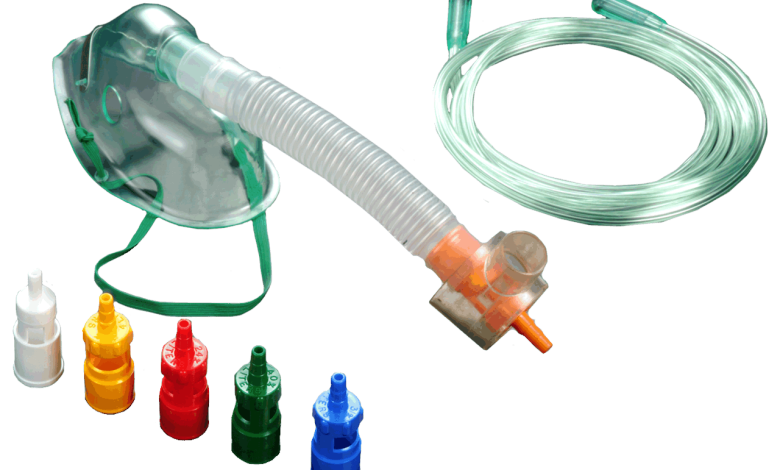Making Sense of The Venturi Mask in Oxygen Therapy

Oxygen therapy plays a vital role in the medical management of patients with respiratory disorders, and various devices are available to deliver precise concentrations of oxygen. One such device, the Venturi mask, has become a cornerstone in the field of respiratory care.
This article delves into the intricacies of the Venturi mask, exploring its uses, advantages, and differences compared to other oxygen delivery devices.
What is the Venturi Mask Used For?
The Venturi mask is a medical device designed to deliver a controlled and specific concentration of oxygen to patients requiring supplemental oxygen therapy. The first Venturi mask was made by a British doctor named Earl James Moran Campbell. He named it after an Italian scientist, Giovanni Battista Venturi, who talked about how gases move faster and create less pressure. Campbell used Venturi’s idea to make the oxygen mask work better. This method helps make sure the right amount of oxygen reaches the patient, making it the standard for oxygen masks today.
Venturi Mask Flow Rate
One critical aspect of the Venturi mask is the ability to control the flow rate of oxygen. The flow rate is determined by the healthcare provider based on the patient’s oxygenation needs. Unlike some other oxygen delivery systems, the Venturi mask allows for precise adjustment of the flow rate to achieve the desired oxygen concentration.
The flow rate is typically measured in liters per minute (LPM), and healthcare professionals can select the appropriate flow rate based on the patient’s condition and the prescribed oxygen concentration. Venturi masks are usually set up by a respiratory therapist. However, in some health facilities, they may be set up by a nurse depending on the policy.
Venturi Mask Indications
The use of a Venturi mask is indicated in various clinical scenarios where accurate oxygen concentration delivery is paramount. Some common indications include:
1. Chronic Obstructive Pulmonary Disease (COPD): Patients with COPD often experience fluctuations in their respiratory status. The Venturi mask is particularly useful in these cases, as it allows for precise adjustment of oxygen levels to meet the changing needs of the patient.
2. Respiratory Distress: Individuals experiencing acute respiratory distress may benefit from the controlled oxygen delivery provided by the Venturi mask. This ensures that they receive the appropriate amount of oxygen without the risk of over-oxygenation.
3. Post-Surgical Care: After certain surgeries, patients may require supplemental oxygen. The Venturi mask’s ability to deliver accurate oxygen concentrations makes it a suitable choice in post-surgical care settings.
Venturi Mask COPD
Patients with COPD often present a unique challenge in oxygen therapy. These individuals may have variable respiratory patterns and are sensitive to changes in oxygen levels. The Venturi mask offers a tailored solution for COPD patients by allowing healthcare providers to adjust the oxygen concentration based on the specific needs of the individual. This flexibility is crucial in managing COPD exacerbations and chronic respiratory insufficiency.
Venturi Mask Contraindications
While the Venturi mask is a versatile and effective tool in oxygen therapy, there are certain situations where its use may be contraindicated. Contraindications to Venturi mask use include:
1. Severe Respiratory Distress: In cases of extreme respiratory distress where immediate and high-flow oxygen therapy is required, alternative methods like non-rebreather masks or high-flow nasal cannula may be more appropriate.
2. Inability to Breathe Through the Nose: Since the Venturi mask relies on both nose and mouth breathing for optimal functioning, patients who cannot breathe through their nose may not receive the intended oxygen concentration.
3. Facial Trauma or Deformities: Facial injuries or deformities that prevent a proper mask seal may hinder the effective use of the Venturi mask.
Venturi Mask vs. Non-Rebreather
A common comparison in the realm of oxygen therapy is between the Venturi mask and the non-rebreather mask. Both devices serve the purpose of delivering increased oxygen concentrations, but they differ in their mechanisms and applications.
1. Oxygen Delivery Mechanism: The Venturi mask relies on the Venturi principle, which mixes a specific amount of room air with oxygen to achieve the desired concentration. In contrast, the non-rebreather mask delivers a higher concentration of oxygen by allowing the patient to inhale oxygen from a reservoir bag without entraining room air.
2. Precision vs. High Concentrations: The Venturi mask is preferred when precise control of oxygen concentration is necessary. It is commonly used in situations where a specific oxygen percentage is required, such as in COPD management. On the other hand, the non-rebreather mask is employed when higher concentrations of oxygen are needed, as it can deliver almost 100% oxygen.
3. Use in COPD: While both masks can be used in COPD patients, the Venturi mask is often favored due to its ability to provide accurate oxygen concentrations without the risk of excessive oxygenation, which can be a concern in COPD cases.
Venturi Mask Oxygen Percentage
The oxygen percentage delivered by a Venturi mask depends on the color-coded adapter selected and the corresponding flow rate. Commonly used colors and their associated oxygen percentages include:
• White (24%): 4 LPM
• Blue (28%): 4 LPM
• Yellow (35%): 8 LPM
• Red (40%): 8 LPM
• Green (60%): 12 LPM
It’s crucial for healthcare providers to be familiar with the color-coding system to ensure accurate oxygen delivery.
Conclusion
In oxygen therapy, the Venturi mask stands out as a versatile and precise tool for delivering controlled concentrations of oxygen. Its application spans various clinical scenarios, with a particular emphasis on conditions where accurate oxygen titration is crucial. Understanding the indications, contraindications, and differences between the Venturi mask and other oxygen delivery devices is essential for healthcare professionals to provide optimal care for patients with respiratory disorders.
As technology and medical practices evolve, the Venturi mask remains a stalwart in the arsenal of respiratory support tools, contributing to improved patient outcomes and enhanced respiratory care.





